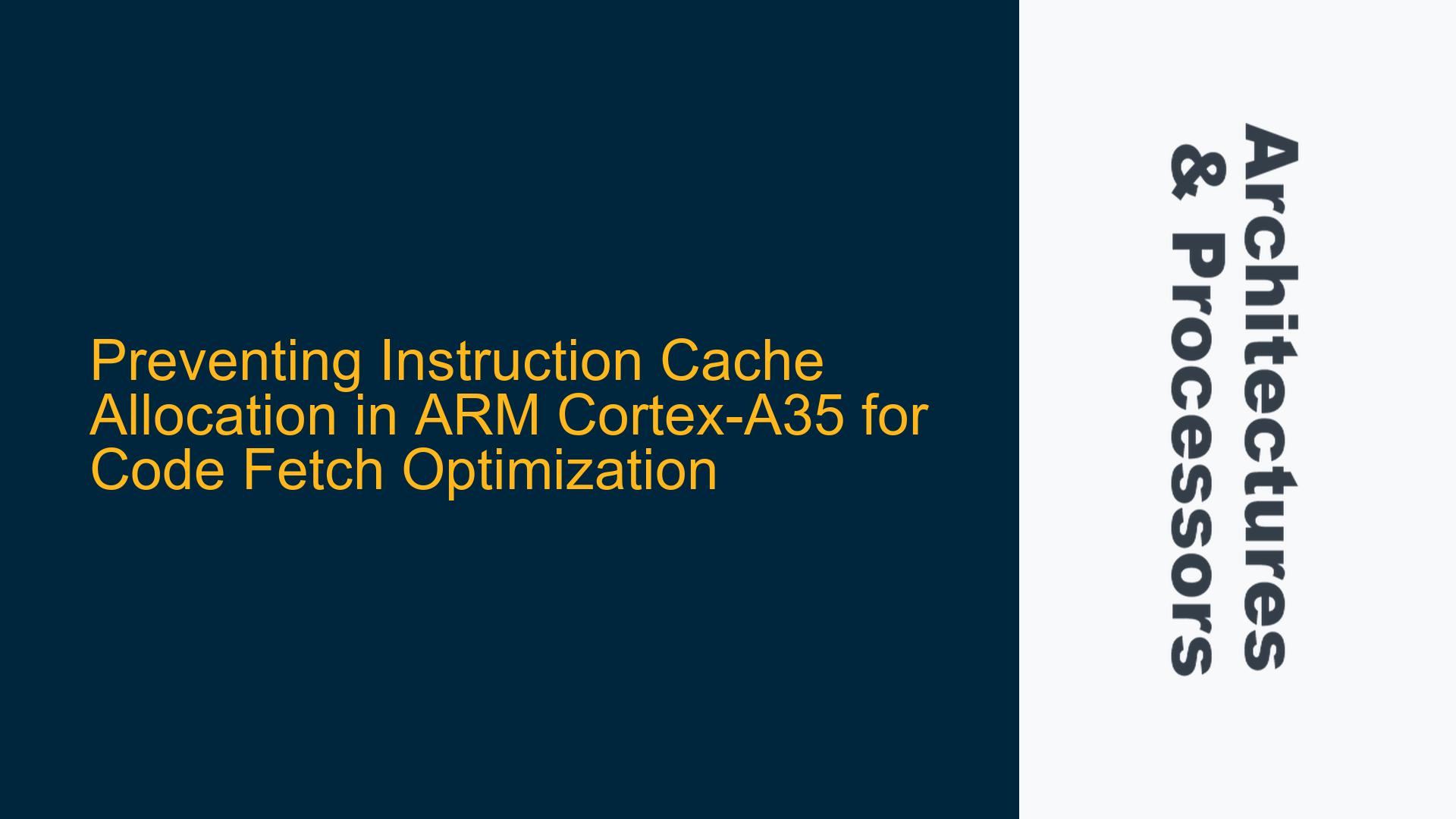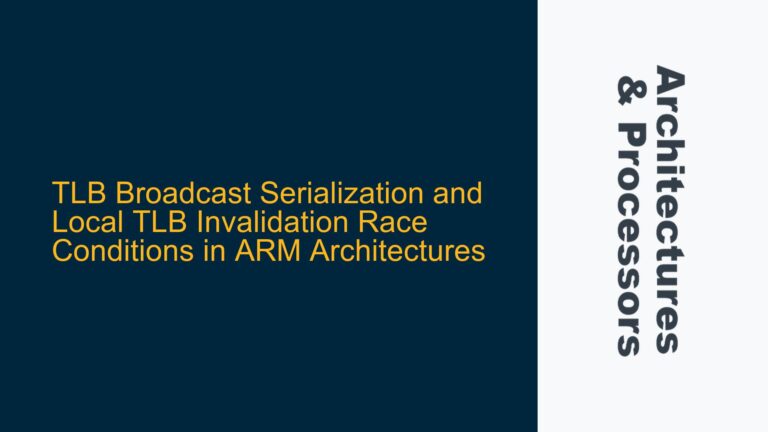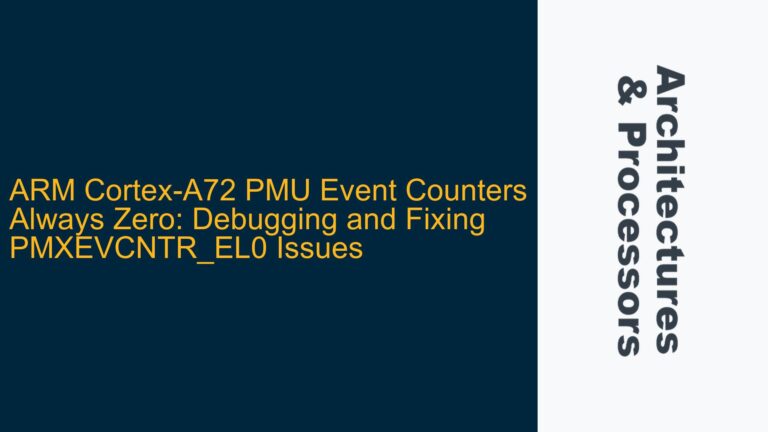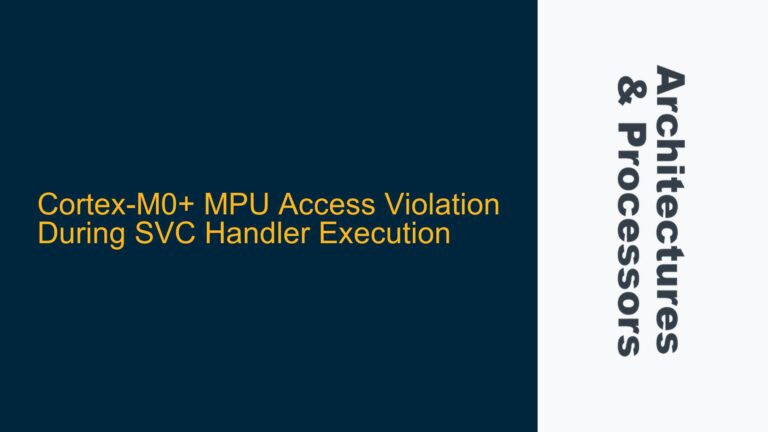ARM Cortex-A35 Instruction Cache Allocation Challenges During Code Fetch
The ARM Cortex-A35 processor, a member of the ARMv8-A architecture family, is designed for energy-efficient performance, making it a popular choice for embedded systems. However, one of the challenges that developers face when working with the Cortex-A35 is managing cache allocation policies, particularly for instruction fetches. Unlike data cache allocation, which can be controlled using write allocation (WA) and read allocation (RA) policies, instruction cache allocation does not have a direct equivalent mechanism. This can lead to inefficiencies, especially in multi-core systems where cache interference between cores can degrade performance.
The primary issue revolves around the inability to prevent instruction cache allocation during code fetch operations. This limitation can be problematic in scenarios where developers want to minimize cache pollution or ensure deterministic execution times for specific code segments. For example, in real-time systems, it may be desirable to prevent certain code sections from being cached to avoid interference with other processes or cores. The Cortex-A35’s unified L2 cache further complicates this, as it serves both data and instruction caches, making it difficult to isolate cache usage for specific purposes.
The discussion highlights the need for a mechanism to control instruction cache allocation, similar to how data cache allocation can be managed. This is particularly relevant in systems where the L2 cache is shared among multiple cores, and developers want to ensure that critical code sections do not interfere with other processes. The absence of such a mechanism can lead to increased latency and reduced performance, especially in multi-core environments where cache contention is a concern.
Memory Management Unit (MMU) Configuration and Cacheability Attributes
One of the primary reasons for the inability to directly control instruction cache allocation in the Cortex-A35 lies in the architecture’s design and the way cacheability attributes are managed. The ARMv8-A architecture provides a Memory Management Unit (MMU) that allows developers to configure memory regions with specific cacheability attributes. These attributes determine whether a memory region is cacheable or non-cacheable, and they apply to both data and instruction caches.
However, the granularity of these attributes is at the page level, meaning that entire memory pages must be marked as cacheable or non-cacheable. This can be problematic when developers want to prevent only specific code sections from being cached, as it requires isolating those sections into separate memory pages. Additionally, the Cortex-A35’s unified L2 cache means that even if a memory region is marked as non-cacheable for the L1 instruction cache, it may still be cached in the L2 cache, leading to potential interference with other cores.
Another factor contributing to the issue is the lack of explicit control over instruction cache allocation policies. While data cache allocation can be managed using WA and RA policies, there is no equivalent mechanism for instruction cache allocation. This means that whenever a code fetch operation occurs, the processor will automatically allocate a cache line in the instruction cache, regardless of whether the developer wants to prevent this behavior.
The Cortex-A35’s cache architecture also plays a role in this limitation. The L1 instruction cache is typically smaller and faster than the L2 cache, and it is designed to store frequently accessed code segments. However, the lack of control over instruction cache allocation means that even infrequently accessed code segments may be cached, leading to inefficient use of cache resources. This can be particularly problematic in systems with limited cache sizes, where every cache line is valuable.
Implementing Non-Cacheable Memory Regions and Cache Partitioning
To address the challenge of preventing instruction cache allocation during code fetch operations, developers can leverage the Memory Management Unit (MMU) to configure specific memory regions as non-cacheable. This approach involves marking the memory pages containing the code segments that should not be cached as non-cacheable in the MMU’s page table entries. By doing so, the processor will bypass the instruction cache for those memory regions, fetching instructions directly from main memory instead.
The first step in implementing this solution is to identify the code segments that should not be cached. This can be done by analyzing the application’s performance and identifying sections of code that are either infrequently accessed or have strict timing requirements. Once these code segments have been identified, they should be isolated into separate memory sections using the linker script. This ensures that the code segments are aligned with memory page boundaries, allowing the MMU to apply the non-cacheable attribute to the entire page.
Next, the MMU’s page table entries for the identified memory regions should be configured with the appropriate cacheability attributes. In the ARMv8-A architecture, this can be done by setting the appropriate bits in the page table entries to mark the memory regions as inner non-cacheable and/or outer non-cacheable. The inner cacheability attribute applies to the L1 instruction cache, while the outer cacheability attribute applies to the L2 cache. By marking a memory region as non-cacheable, the processor will bypass the instruction cache for code fetch operations, fetching instructions directly from main memory instead.
In addition to configuring non-cacheable memory regions, developers can also consider using cache partitioning techniques to minimize cache interference between cores. Cache partitioning involves dividing the cache into separate regions, each dedicated to a specific core or process. This can be achieved using cache coloring, a technique that assigns specific cache lines to specific cores based on a predefined color scheme. While cache coloring is typically used for data caches, it can also be applied to instruction caches to some extent, depending on the processor’s architecture.
Another approach to minimizing cache interference is to use cache locking, a technique that allows developers to lock specific cache lines in the cache, preventing them from being evicted. This can be useful for ensuring that critical code segments remain in the cache, reducing the likelihood of cache misses. However, cache locking is typically more effective for data caches than for instruction caches, as instruction caches are designed to be more dynamic in nature.
Finally, developers should consider the impact of non-cacheable memory regions on overall system performance. While preventing instruction cache allocation can reduce cache interference, it can also increase latency, as instructions must be fetched directly from main memory. Therefore, it is important to carefully balance the need for deterministic execution times with the potential performance impact of bypassing the instruction cache. This may involve conducting performance profiling and tuning to identify the optimal configuration for the specific application.
In conclusion, while the ARM Cortex-A35 does not provide a direct mechanism for preventing instruction cache allocation during code fetch operations, developers can leverage the MMU’s cacheability attributes and cache partitioning techniques to achieve similar results. By carefully configuring non-cacheable memory regions and minimizing cache interference, developers can optimize the performance of their embedded systems and ensure deterministic execution times for critical code segments.






